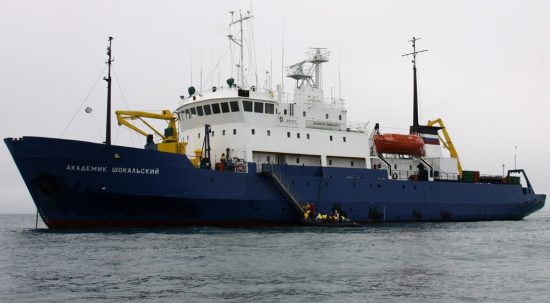Revealing the magic and mystery of the Russian High Arctic sailing the Northeast Passage in Akademik Shokalskiy.
Few passenger vessels have ever completed a full transit of the Northeast Passage between Anadyr and Murmansk in Russia. However, as changes in sea ice conditions become more apparent, it is now possible to do so for a brief period next summer on a very special expedition cruise.
The UK based tour operator, Swoop-Arctic is offering a four-week expedition cruise aboard the Akademik Shokalskiy, an ice-strengthened boutique cruise ship through the Northeast Passage to reveal the magic and mystery of the Russian High Arctic.
Carrying just 48 passengers Akademik Shokalskiy was built in 1984 Soviet oceanographic research, which some like to imagine as naval espionage. This fully ice strengthened expedition vessel is ideally suited to Antarctic expeditions due to its strength, manoeuvrability and small passenger numbers. In 1998 she was fully refurbished to serve as a research ship for Arctic and Antarctic work; and is now also used for expedition cruisingcarrying her passengers in twin or triple share cabins, approximately half of which have private facilities. All cabins have outside windows or portholes and ample storage space. On board there is a combined bar/library lounge area and a dedicated lecture room.
The emphasis and focus of every expedition is getting passengers ashore as often as possible for as long as possible with maximum safety and comfort. An extremely experienced Captain and crew run the ship, and expeditions are accompanied by a passionate and knowledgeable expedition team from Swoop Artic.
The Northern Sea Route itinerary that Akademik Shokalskiy will undertake begins on 19th August and last until 15th September 2019. It traces the journey made by historic polar explorer, Adolf Erik Nordenskiold, travelling through Russian-controlled waters and narrow fjords rich in both bird and marine life, experiencing the warmth of remote Chukchi communities along the way and visiting sites of important historic, cultural and archaeological significance.
One of the focal points of the first week of the voyage is a trip to Whale Bone Alley on Yttygran Island in the Bering Sea. A unique pathway created from Bowhead whale jawbones, which is thought to date back to the 14th century, forms one of the most intriguing archaeological sites in the Arctic. In addition, the surrounding waters remain rich feeding grounds for marine life, offering a good chance for passengers to spot Gray whales and walrus from the vantage point of a Zodiac RIB.
Another key destination in this waterway at the top of the world, which has been a hugely significant trade route for many centuries, is Wrangel Island, a Federal Nature Reserve and UNESCO World Heritage Site of international importance. Often referred to as a polar bear maternity ward, due to the large number of cubs born on the island, it is the perfect place in which to guarantee sightings of these magnificent creatures, together with the possibility of spotting other species such as musk ox, Arctic Fox, snow geese and the largest population of Pacific walrus in Arctic waters.
Each section of this epic journey brings new and interesting discoveries. The New Siberian Islands, for example, located between the Laptev and East Siberian Seas, are best known for the discovery of the remains of a 39,000-year-old Woolly mammoth, preserved intact beneath the ice for centuries. Fossils, bones, tusks and even entire skeletons have also been recovered from this archipelago, some of which date as far back as 200,000 years ago.
The last major archipelago in the world to be put on the map, as recently as 1913, the ice-covered Severnaya Zemlya Islands feature impressive dome-shaped glaciers, which calve icebergs on a regular basis. Colonies of Ivory gulls and collared lemmings also make these isles their home.
Franz Joseph Land, named in 1870 after the Emperor of the day, comprises 192 islands – the majority of which are glaciated – is situated just 10 degrees from the North Pole. This is the final land mass of the voyage to be explored before crossing the Barents Sea towards Murmansk. With the chance to learn about a history of scientific research, exploratory expeditions and unusual geology – including the famous spherical boulders known as the Devil’s Marbles, it provides a fascinating finale to the journey.
Plus, this northernmost archipelago boasts a multitude of Siberian wildlife, giving passengers the chance to see guillemots and kittiwakes in the thousands, polar bears, beluga and bowhead whales and possibly even narwhal, sporting their singular unicorn-like tusks.
Prices for this 28-day voyage start from US $21,900pp for a Main Deck twin cabin with washbasin, porthole and shared shower and toilet facilities. Several other levels of accommodation are available, including Superior, which offers bunk beds, private bathroom and window from $23,900pp, up to the Heritage Suite at $29,900ppp, with its large lounge, separate double bedroom, private bathroom and large windows.
Pre and post-cruise transfers, all meals and accommodation on board Akademik Shokalskiy, plus all shore excursions during the voyage are covered in these prices. International and domestic flights are not included.

